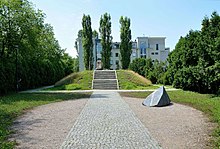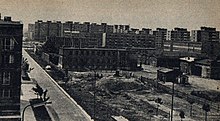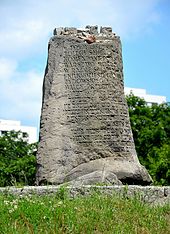270:
civilians. Among them lies
Mordechaj Anielewicz, the Commander in Chief. On May 8, 1943, surrounded by the Nazis after three weeks of struggle, many perished or took their own lives, refusing to perish at the hands of their enemies. There were several hundred bunkers built in the Ghetto. Found and destroyed by the Nazis, they became graves. They could not save those who sought refuge inside them, yet they remain everlasting symbols of the Warsaw Jews’ will to live. The bunker at Miła Street was the largest in the ghetto. It is the place of rest of over one hundred fighters, only some of whom are known by name. Here they rest, buried as they fell, to remind us that the whole earth is their grave.
290:
167:
258:
41:
232:
149:
In
October 1940, the governor of Nazi German-occupied Warsaw ordered city officials to begin construction of a ghetto for Jews in an area of Warsaw formerly used for quarantine during epidemics; it was completed on 15 November 1940. The initial population of Jews confined to the ghetto was 400,000.
193:
The location of the is now known. It is to be forced open tomorrow... On the average the raiding parties shoot 30 to 50 Jews each night... Today we blew up a concrete building which we had not been able to destroy by fire. In this operation we learned that the blowing up of a building is a very
269:
Grave of the fighters of the Warsaw Ghetto
Uprising built from the rubble of Miła Street, one of the liveliest streets of pre-war Jewish Warsaw. These ruins of the bunker at 18 Miła Street are the place of rest of the commanders and fighters of the Jewish Combat Organization, as well as some
214:
by ingesting poison rather than surrender, though a group of about 30 eluded the SS by escaping through the only un-blocked door of the six. They crawled through the Ghetto through a sewer until able to emerge near Prosta Street to the "Aryan side" of Warsaw on May 10, 1943.
280:
The current numbering of the buildings on Mila Street does not correspond to the wartime numbering. The memorial is now located at the intersection of Miła and Dubois
Streets while the current Miła 18 is an apartment block about 700 metres to the west.
174:
The bunker at Miła 18 was initially constructed by a group of Polish partisans and armed underground resistance fighters against the
Germans. They were joined there by the ŻOB fighters after their hideout, at 29 Miła Street, had been discovered.
157:
reported to SS-Obergruppenfuehrer and
General of Police Krueger that 56,065 of the remaining Jews of the Warsaw ghetto were deported to death camps or exterminated by gunshot, explosion, fire, or asphyxiation.
150:
All windows, doors, and other exits to the rest of Warsaw were bricked up. From July to
October 1942, over 310,300 Jews were removed from the ghetto, for transport to concentration camps or due to death.
243:) visited the ruins above the former ZOB command bunker. The ruins were not built over, so as "not to disturb what is recognized as a grave site by the Jewish community".
277:
Non-invasive surveys confirming subsurface evidence of the bunker and tunnel systems were carried out in 2021 by the
Society of Exploration Geophysicists.
194:
lengthy process and takes an enormous amount of explosives. The best and only method for destroying the Jews therefore still remains the setting of fires.
265:
In 2006, a new obelisk designed by Hanna
Szmalenberg and Marek Moderau was added to the memorial. The inscription in Polish, English and Yiddish reads:
222:
The whole Ghetto was searched today by raiding parties... are resolved not to terminate the large-scale operation until the last Jew has been destroyed.
520:
799:
769:
789:
562:
715:
246:
In 1946, the monument known as
Anielewicz Mound, made of the rubble of Miła Street houses, was erected. A commemorative stone inscribed in
671:
794:
784:
182:, when the bunker beneath 18 Mila Street was found by the Nazis, there were around 300 people living there. The bunker had six exits.
274:
The names of 51 Jewish fighters whose identities have been established by historians are engraved on the front of the obelisk.
130:
764:
754:
774:
126:
705:
498:. University of South Florida: Florida Center for Instructional Technology, College of Education. 2005
459:
289:
592:
537:
Note: Bandit was the word used by the Germans for Polish partisans and armed underground fighters.
166:
491:
257:
779:
759:
179:
635:
305:
199:
8:
700:
556:
634:
Miazga, Colin; Bauman, Paul; McClymont, Alastair; Slater, Chris (1 September 2021).
643:
617:
251:
154:
247:
118:
106:
647:
636:"Geophysical investigation of the Miła 18 resistance bunker in Warsaw, Poland"
261:
Commemorative stone on top of the mound, visible stones put by Jewish visitors
748:
730:
717:
521:"Stroop's Final Report on the Battles in the Warsaw Ghetto Revolt (May 1943)"
231:
186:
134:
40:
69:
Hanna Szmalenberg and Marek Moderau (obelisk); Unknown (commemorative stone)
403:
352:
240:
211:
207:
138:
16:
Underground bunker of the Jewish resistance in the Warsaw Ghetto during WW2
198:
The armed resistance fighters surrendered, but the ŻOB command, including
448:
206:
into the shelter to force the occupants out. Anielewicz, his girlfriend
202:, the leader of the Warsaw Ghetto uprising, stood firm. The Nazis threw
293:
Obelisk at the foot of the mound with the names of 51 Jewish fighters
19:
This article is about a location. For the novel named after it, see
203:
77:
20:
640:
First International Meeting for Applied Geoscience & Energy
58:
701:
Images of Graves of the Fighters of the Warsaw Ghetto Uprising
239:
In July 1945, survivors of the Jewish Underground (among them
633:
678:. Warsaw: Polin Museum of the History of Polish Jews. 2017
284:
153:
From 17 April 1943 to 18 May 1943, SS Brigadefuehrer
178:On 8 May 1943, three weeks after the start of the
492:"The Stroop Report: The Warsaw Ghetto is No More"
125:) was the headquarters and hidden shelter of the
746:
137:in Poland during the Nazi German occupation of
547:Leociak, J. (2011). "Dom Spotkań z Historią".
161:
170:Postwar reconstruction of the Miła 18 bunker
587:
585:
549:Spojrzenia na warszawskie getto. Ulica Miła
527:. Nuremberg Documents, PS-1061. 16 May 1943
515:
513:
561:: CS1 maint: location missing publisher (
39:
629:
627:
486:
484:
482:
666:
664:
582:
510:
288:
256:
230:
165:
546:
800:Muranów (City Information System area)
770:Jewish resistance during the Holocaust
747:
624:
479:
790:Polish resistance during World War II
706:"The Ghetto Fights," by Marek Edelman
661:
218:From the Stroop Report, 8 May 1943:
672:"Anielewicz's Bunker (Miła Street)"
285:Jewish fighters who died at Miła 18
13:
579:, Książka i Wiedza, Warszawa 1999.
551:(in Polish). Warszawa. p. 26.
14:
811:
795:Warsaw Ghetto Uprising insurgents
785:Monuments and memorials in Warsaw
694:
618:"Mila 18 Bunker site photograph"
254:was placed on top of the mound.
210:and many of his staff committed
610:
569:
540:
226:
1:
472:
144:
597:www.jewishvirtuallibrary.org
525:www.jewishvirtuallibrary.org
7:
648:10.1190/segam2021-3594939.1
10:
816:
162:The Warsaw Ghetto uprising
127:Jewish Combat Organization
18:
91:
83:
73:
65:
54:
50:
38:
31:
235:Miła 18 memorial in 1964
45:View of Miła 18 Memorial
765:Warsaw in World War II
755:Warsaw Ghetto Uprising
294:
272:
262:
236:
224:
196:
180:Warsaw Ghetto Uprising
171:
775:Jewish Polish history
292:
267:
260:
234:
220:
191:
169:
113:), also known as the
436:Szulamit Szuszkowska
306:Mordechaj Anielewicz
200:Mordechaj Anielewicz
92:Completion date
731:52.2515°N 20.9923°E
727: /
593:"The Stroop Report"
577:Zagłada i powstanie
464:Moszek Zylbertszajn
460:Rachelka Zylberberg
111:Bunkier Anielewicza
84:Beginning date
33:Bunkier Anielewicza
28:
708:, pp. 17-39 (2004)
343:Efraim Fondamiński
295:
263:
237:
172:
123:Kopiec Anielewicza
26:
411:Jardena Rozenberg
131:Jewish resistance
103:Anielewicz Bunker
99:
98:
27:Anielewicz Bunker
807:
742:
741:
739:
738:
737:
736:52.2515; 20.9923
732:
728:
725:
724:
723:
720:
688:
687:
685:
683:
668:
659:
658:
656:
654:
631:
622:
621:
614:
608:
607:
605:
603:
589:
580:
573:
567:
566:
560:
552:
544:
538:
536:
534:
532:
517:
508:
507:
505:
503:
488:
397:Majloch Perelman
360:Miriam Hajnsdorf
337:Icchak Dembiński
322:Icchak Blaustein
313:Heniek Bartowicz
115:Anielewicz Mount
43:
29:
25:
815:
814:
810:
809:
808:
806:
805:
804:
745:
744:
735:
733:
729:
726:
721:
718:
716:
714:
713:
712:
697:
692:
691:
681:
679:
670:
669:
662:
652:
650:
632:
625:
616:
615:
611:
601:
599:
591:
590:
583:
574:
570:
554:
553:
545:
541:
530:
528:
519:
518:
511:
501:
499:
490:
489:
480:
475:
470:
439:Mojsze Waksfeld
433:Moniek Sztengel
416:first name only
394:Rywka Pasamonik
383:first name only
287:
229:
164:
147:
46:
34:
24:
17:
12:
11:
5:
813:
803:
802:
797:
792:
787:
782:
777:
772:
767:
762:
757:
710:
709:
703:
696:
695:External links
693:
690:
689:
660:
623:
609:
581:
568:
539:
509:
477:
476:
474:
471:
469:
468:
465:
462:
457:
454:
451:
446:
445:Icchak Wichter
443:
442:Olek Wartowicz
440:
437:
434:
431:
430:Szyja Szpancer
428:
425:
422:
419:
412:
409:
408:Miriam Rotblat
406:
401:
398:
395:
392:
391:Abraham Orwacz
389:
386:
379:
378:Jaffa Lewender
376:
375:Ziuta Klejnman
373:
370:
367:
364:
361:
358:
355:
350:
347:
344:
341:
338:
335:
332:
331:Icchak Chadasz
329:
326:
323:
320:
317:
314:
311:
310:Nate Bartmeser
308:
303:
302:Małka Alterman
300:
296:
286:
283:
228:
225:
189:, 7 May 1943:
163:
160:
146:
143:
97:
96:
93:
89:
88:
85:
81:
80:
75:
71:
70:
67:
63:
62:
56:
52:
51:
48:
47:
44:
36:
35:
32:
15:
9:
6:
4:
3:
2:
812:
801:
798:
796:
793:
791:
788:
786:
783:
781:
780:Mass suicides
778:
776:
773:
771:
768:
766:
763:
761:
760:Warsaw Ghetto
758:
756:
753:
752:
750:
743:
740:
707:
704:
702:
699:
698:
677:
676:sztetl.org.pl
673:
667:
665:
649:
645:
642:: 3096–3100.
641:
637:
630:
628:
620:. Sztetl org.
619:
613:
598:
594:
588:
586:
578:
572:
564:
558:
550:
543:
526:
522:
516:
514:
497:
493:
487:
485:
483:
478:
466:
463:
461:
458:
456:Hirsz Wroński
455:
452:
450:
447:
444:
441:
438:
435:
432:
429:
426:
423:
420:
417:
413:
410:
407:
405:
404:Lutek Rotblat
402:
400:Aron Rajzband
399:
396:
393:
390:
387:
384:
380:
377:
374:
371:
368:
365:
363:Aron Halzband
362:
359:
356:
354:
351:
348:
345:
342:
339:
336:
333:
330:
327:
325:Melach Błones
324:
321:
318:
316:Franka Berman
315:
312:
309:
307:
304:
301:
299:Chaim Akerman
298:
297:
291:
282:
278:
275:
271:
266:
259:
255:
253:
249:
244:
242:
233:
223:
219:
216:
213:
209:
205:
201:
195:
190:
188:
187:Stroop Report
183:
181:
176:
168:
159:
156:
155:Jürgen Stroop
151:
142:
140:
136:
135:Warsaw Ghetto
133:group in the
132:
128:
124:
120:
116:
112:
108:
104:
94:
90:
86:
82:
79:
76:
72:
68:
64:
60:
57:
53:
49:
42:
37:
30:
22:
711:
680:. Retrieved
675:
651:. Retrieved
639:
612:
600:. Retrieved
596:
576:
575:C.Lubetkin,
571:
548:
542:
529:. Retrieved
524:
500:. Retrieved
496:fcit.usf.edu
495:
453:Zeew Wortman
427:Basia Sylman
424:Szmuel Sobol
421:Jerzy Sarnak
415:
388:Sewek Nulman
382:
372:Salke Kamień
369:Mira Izbicka
353:Mira Fuchrer
346:Towa Frenkel
334:Nesia Cukier
319:Tosia Berman
279:
276:
273:
268:
264:
245:
241:Simcha Rotem
238:
221:
217:
212:mass suicide
208:Mira Fuchrer
197:
192:
184:
177:
173:
152:
148:
139:World War II
122:
114:
110:
102:
100:
734: /
467:Sara Żagiel
449:Arie Wilner
349:Emus Frojnd
328:Berl Braude
227:Remembrance
749:Categories
722:20°59′32″E
719:52°15′05″N
473:References
366:Rut Hejman
340:Józef Fass
145:Background
95:1946, 2006
557:cite book
357:Wolf Gold
185:From the
129:(ŻOB), a
602:22 April
531:22 April
502:22 April
204:tear gas
74:Material
66:Designer
61:, Poland
55:Location
414:Salka (
381:Lolek (
252:Yiddish
78:Granite
21:Mila 18
248:Polish
119:Polish
107:Polish
59:Warsaw
682:3 May
653:3 May
684:2024
655:2024
604:2024
563:link
533:2024
504:2024
250:and
101:The
87:1946
644:doi
751::
674:.
663:^
638:.
626:^
595:.
584:^
559:}}
555:{{
523:.
512:^
494:.
481:^
141:.
121::
109::
686:.
657:.
646::
606:.
565:)
535:.
506:.
418:)
385:)
117:(
105:(
23:.
Text is available under the Creative Commons Attribution-ShareAlike License. Additional terms may apply.




